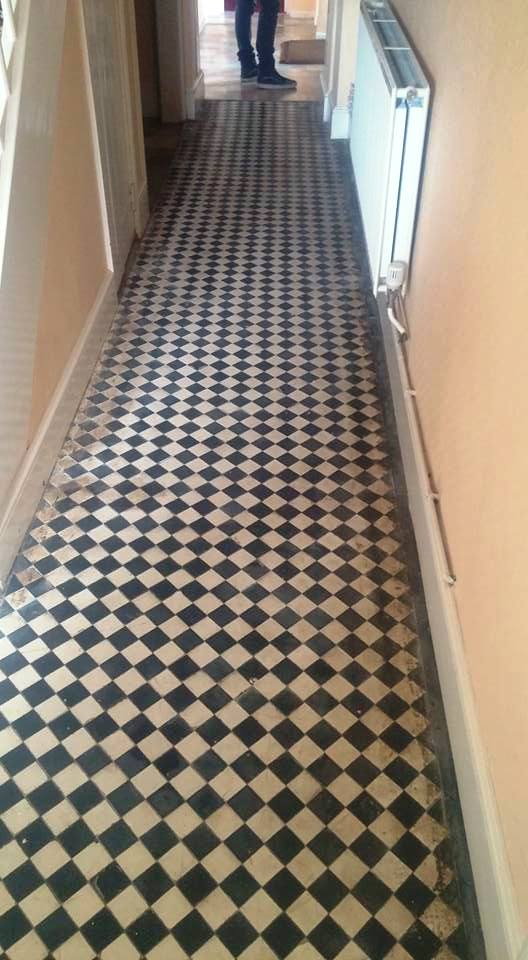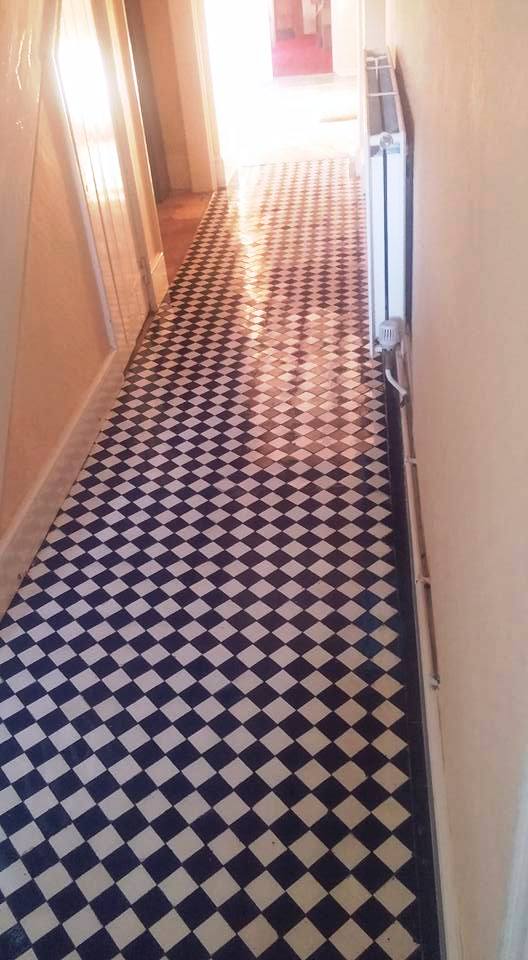
During my visit I took some moisture readings because these old floors will not have had a damp proof membrane installed and if the moisture levels are too high it can restrict when this type of work can be done due to the sealers needing the floor to be dry(ish), in order to cure. I also did a test clean to show the customers what level of cleaning could be achieved and looked at areas of loose tiles to see if any replacement tiles would need to be sourced. I always like to do a test clean as it demonstrates what can be achieved and it also allows me to work out which methods and products work best.
Cleaning and Repairing a Victorian Tiled Hallway Floor
With the customers happy with the quote I returned to complete the work starting by covering the wooden skirting and bottom of the stairs to protect the paint and carpet from splashing. I then applied a strong dilution of Tile Doctor Pro-Clean on to the floor, ensuring even coverage and keeping an eye on the floor to make sure that it didn’t dry out. Pro-Clean is quite a flexible product than can strip off old sealers when applied in a strong dilution.After a short time, I set to work scrubbing the Pro-Clean into the floor with a 400-grit diamond pad fitted to a rotary floor buffer. I also used 400-grit hand held burnishing block to cover the corners and any edges not reached by my machine. Once I was satisfied that the tiles were as good as they could be I rinsed the floor to remove the now soiled alkaline cleaner before giving the floor an acid wash with Acid Gel to neutralise with any inherent salts in dfdfthe tiles.
Before I left for the day I fixed the loose tiles back in place, re-grouted the areas that I had replaced tiles and left an air mover on the floor to aid in the drying process. I also suggested that the radiators in the hallway were turned on overnight to further aid the drying process. Occasionally these types of floors need to be left for several days to dry but it is worth the wait and the floors can be used in the meantime provided only socks and indoor shoes are used and care is taken not to get the floor dirty.
Sealing a Victorian Tiled Hallway Floor
Upon returning the next day I tested the moisture content of the floor and was pleased to find that it was well within acceptable levels for the application of the sealer that I was planning to use. I quickly checked the floor for areas that I felt may be able to be improved and once satisfied a single coat of Tile Doctor Colour Grow sealer was applied to the floor. Colour Grow is a colour enhancing impregnating sealer that occupies the pores in the tile thus preventing dirt from becoming ingrained there.Once this was dry it was followed up by applying two further coats of Tile Doctor Seal and Go Extra which is a compatible surface sealer that leaves a nice subtle sheen finish. Both sealers are fully breathable and able to cope with any damp issues that may impact the floor over time.

The customers were thrilled and said that they were going to reinstate the hallway as the main entrance to the farmhouse in order to show it off to all their visitors!
Source: Victorian Tile Cleaning and Restoration Service in Devon